Tourism's Impact on Economic Development
VerifiedAdded on 2020/04/21
|13
|3778
|211
AI Summary
The assignment examines the influence of tourism growth on economic development. It delves into studies that analyze this relationship, considering factors like barriers to organizational adoption of higher-order customer engagement in tourism, environmentally responsible behavior in ecotourism, and the impact of social tourism on seniors. The analysis also touches upon revitalization efforts in small rural towns through tourism and community resident support for sustainable tourism development.
Contribute Materials
Your contribution can guide someone’s learning journey. Share your
documents today.
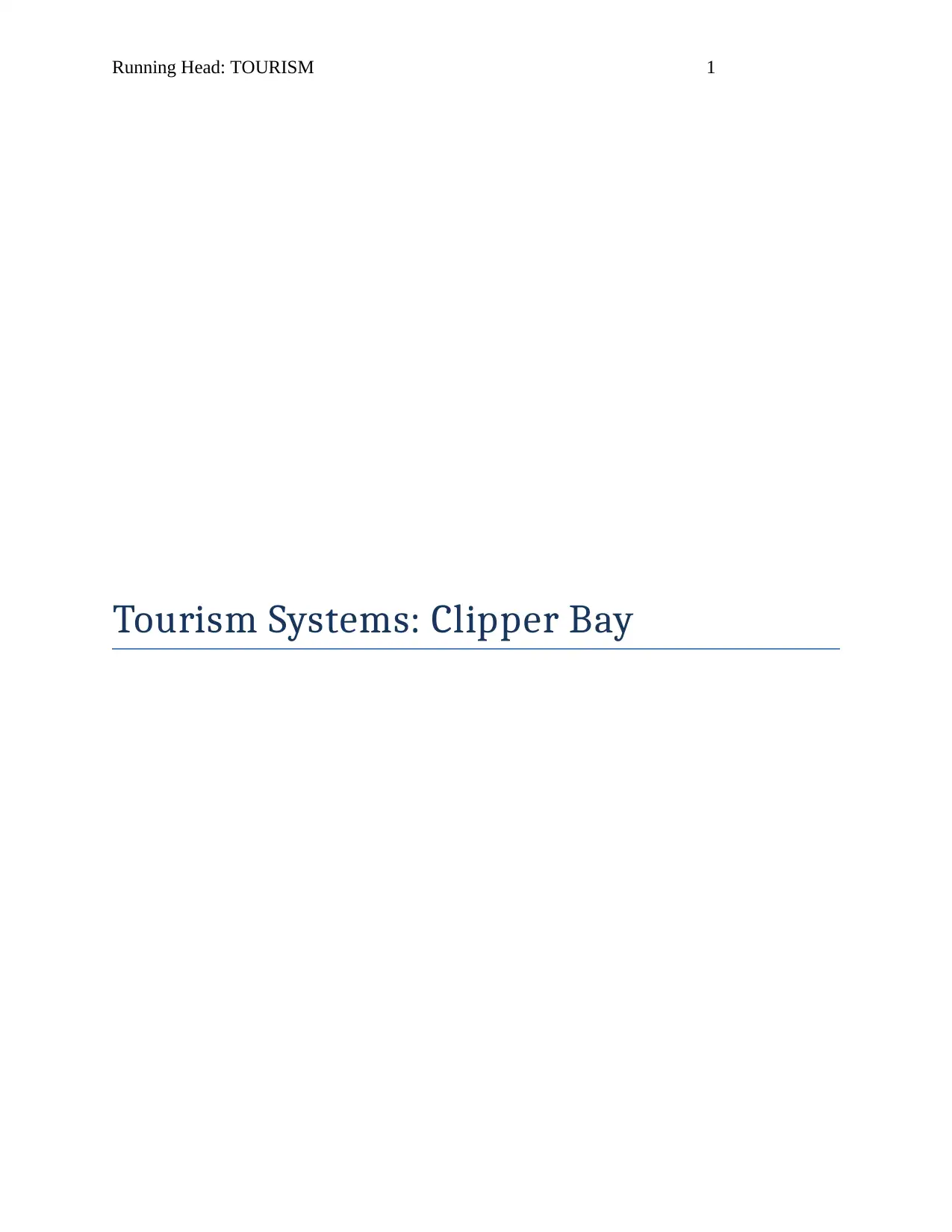
Running Head: TOURISM 1
Tourism Systems: Clipper Bay
Tourism Systems: Clipper Bay
Secure Best Marks with AI Grader
Need help grading? Try our AI Grader for instant feedback on your assignments.
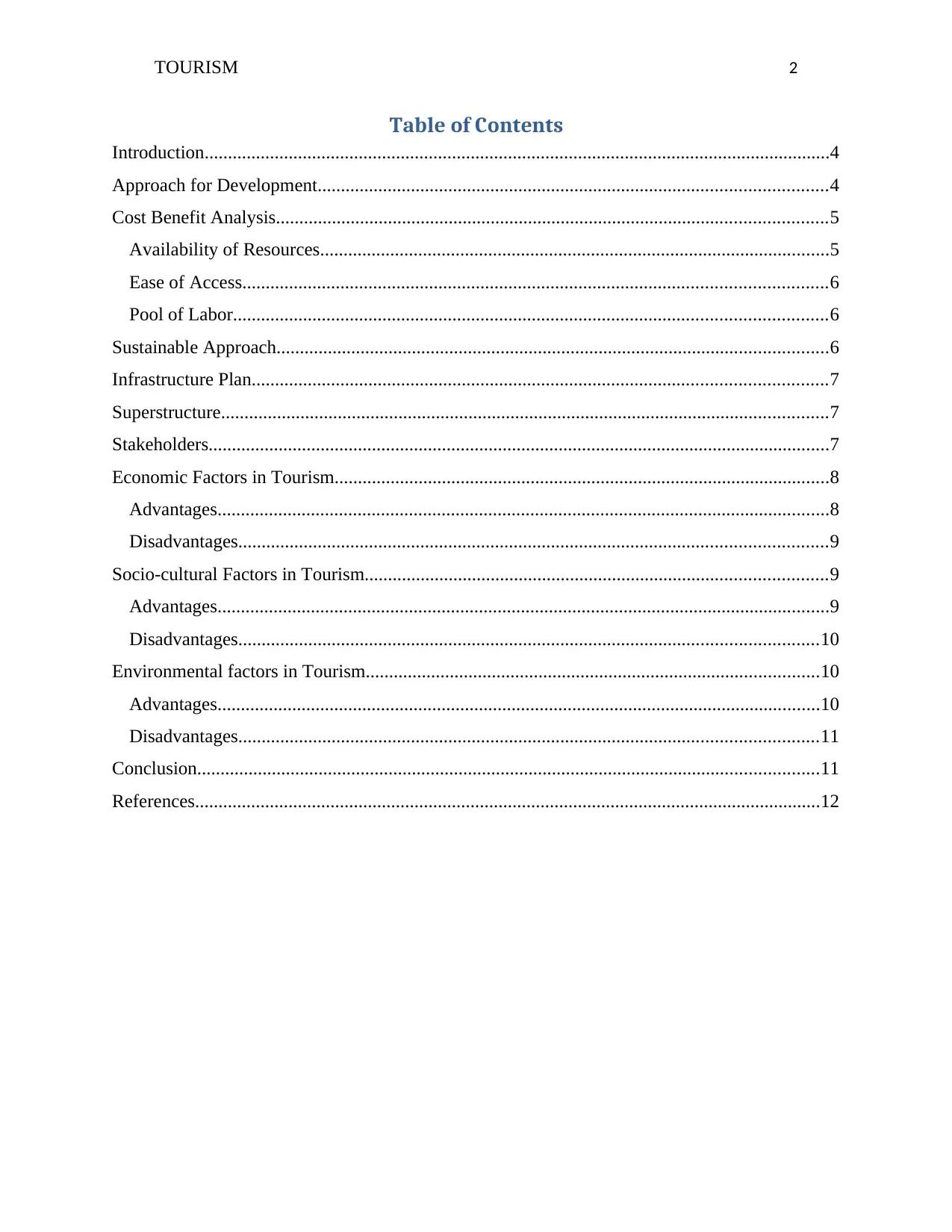
TOURISM 2
Table of Contents
Introduction......................................................................................................................................4
Approach for Development.............................................................................................................4
Cost Benefit Analysis......................................................................................................................5
Availability of Resources.............................................................................................................5
Ease of Access.............................................................................................................................6
Pool of Labor...............................................................................................................................6
Sustainable Approach......................................................................................................................6
Infrastructure Plan...........................................................................................................................7
Superstructure..................................................................................................................................7
Stakeholders.....................................................................................................................................7
Economic Factors in Tourism..........................................................................................................8
Advantages...................................................................................................................................8
Disadvantages..............................................................................................................................9
Socio-cultural Factors in Tourism...................................................................................................9
Advantages...................................................................................................................................9
Disadvantages............................................................................................................................10
Environmental factors in Tourism.................................................................................................10
Advantages.................................................................................................................................10
Disadvantages............................................................................................................................11
Conclusion.....................................................................................................................................11
References......................................................................................................................................12
Table of Contents
Introduction......................................................................................................................................4
Approach for Development.............................................................................................................4
Cost Benefit Analysis......................................................................................................................5
Availability of Resources.............................................................................................................5
Ease of Access.............................................................................................................................6
Pool of Labor...............................................................................................................................6
Sustainable Approach......................................................................................................................6
Infrastructure Plan...........................................................................................................................7
Superstructure..................................................................................................................................7
Stakeholders.....................................................................................................................................7
Economic Factors in Tourism..........................................................................................................8
Advantages...................................................................................................................................8
Disadvantages..............................................................................................................................9
Socio-cultural Factors in Tourism...................................................................................................9
Advantages...................................................................................................................................9
Disadvantages............................................................................................................................10
Environmental factors in Tourism.................................................................................................10
Advantages.................................................................................................................................10
Disadvantages............................................................................................................................11
Conclusion.....................................................................................................................................11
References......................................................................................................................................12
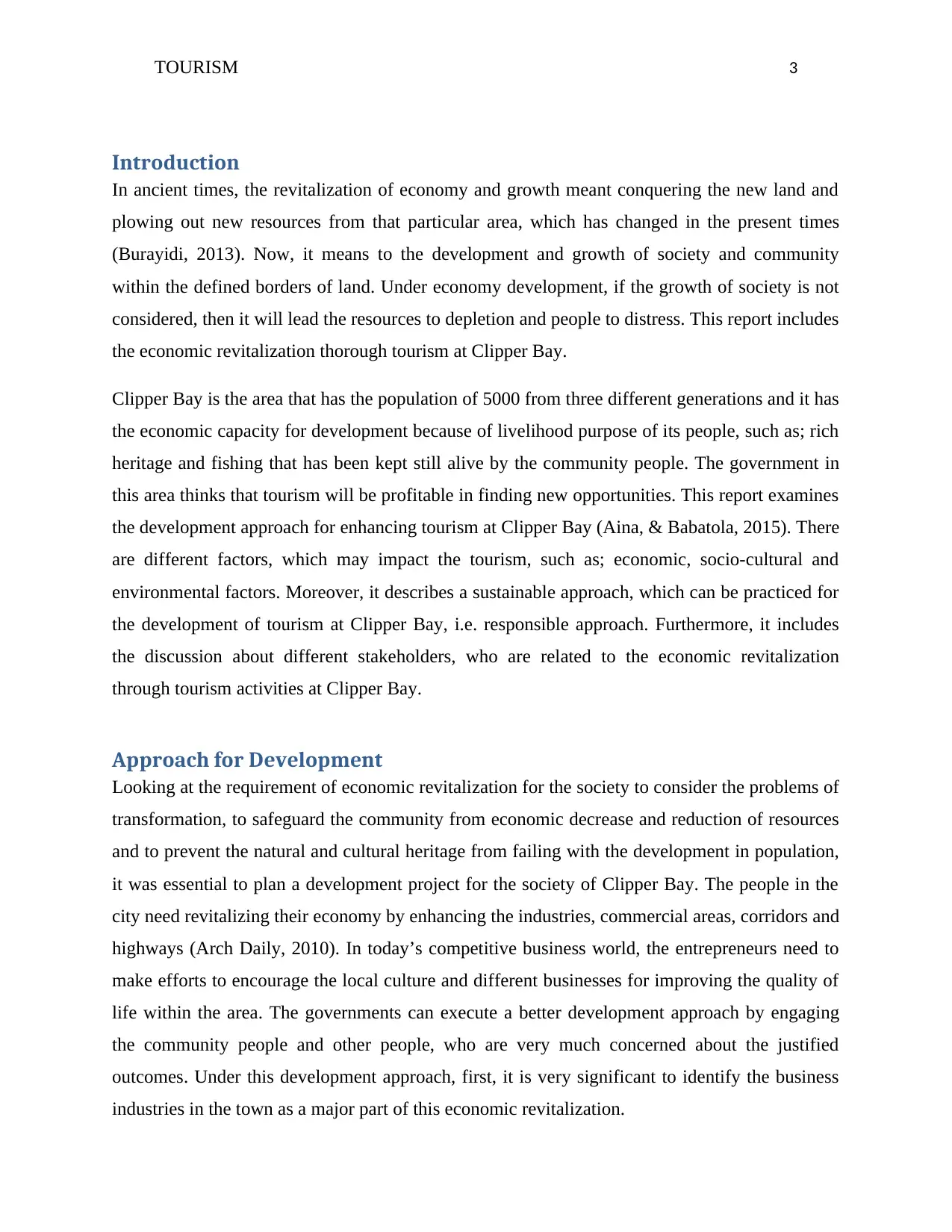
TOURISM 3
Introduction
In ancient times, the revitalization of economy and growth meant conquering the new land and
plowing out new resources from that particular area, which has changed in the present times
(Burayidi, 2013). Now, it means to the development and growth of society and community
within the defined borders of land. Under economy development, if the growth of society is not
considered, then it will lead the resources to depletion and people to distress. This report includes
the economic revitalization thorough tourism at Clipper Bay.
Clipper Bay is the area that has the population of 5000 from three different generations and it has
the economic capacity for development because of livelihood purpose of its people, such as; rich
heritage and fishing that has been kept still alive by the community people. The government in
this area thinks that tourism will be profitable in finding new opportunities. This report examines
the development approach for enhancing tourism at Clipper Bay (Aina, & Babatola, 2015). There
are different factors, which may impact the tourism, such as; economic, socio-cultural and
environmental factors. Moreover, it describes a sustainable approach, which can be practiced for
the development of tourism at Clipper Bay, i.e. responsible approach. Furthermore, it includes
the discussion about different stakeholders, who are related to the economic revitalization
through tourism activities at Clipper Bay.
Approach for Development
Looking at the requirement of economic revitalization for the society to consider the problems of
transformation, to safeguard the community from economic decrease and reduction of resources
and to prevent the natural and cultural heritage from failing with the development in population,
it was essential to plan a development project for the society of Clipper Bay. The people in the
city need revitalizing their economy by enhancing the industries, commercial areas, corridors and
highways (Arch Daily, 2010). In today’s competitive business world, the entrepreneurs need to
make efforts to encourage the local culture and different businesses for improving the quality of
life within the area. The governments can execute a better development approach by engaging
the community people and other people, who are very much concerned about the justified
outcomes. Under this development approach, first, it is very significant to identify the business
industries in the town as a major part of this economic revitalization.
Introduction
In ancient times, the revitalization of economy and growth meant conquering the new land and
plowing out new resources from that particular area, which has changed in the present times
(Burayidi, 2013). Now, it means to the development and growth of society and community
within the defined borders of land. Under economy development, if the growth of society is not
considered, then it will lead the resources to depletion and people to distress. This report includes
the economic revitalization thorough tourism at Clipper Bay.
Clipper Bay is the area that has the population of 5000 from three different generations and it has
the economic capacity for development because of livelihood purpose of its people, such as; rich
heritage and fishing that has been kept still alive by the community people. The government in
this area thinks that tourism will be profitable in finding new opportunities. This report examines
the development approach for enhancing tourism at Clipper Bay (Aina, & Babatola, 2015). There
are different factors, which may impact the tourism, such as; economic, socio-cultural and
environmental factors. Moreover, it describes a sustainable approach, which can be practiced for
the development of tourism at Clipper Bay, i.e. responsible approach. Furthermore, it includes
the discussion about different stakeholders, who are related to the economic revitalization
through tourism activities at Clipper Bay.
Approach for Development
Looking at the requirement of economic revitalization for the society to consider the problems of
transformation, to safeguard the community from economic decrease and reduction of resources
and to prevent the natural and cultural heritage from failing with the development in population,
it was essential to plan a development project for the society of Clipper Bay. The people in the
city need revitalizing their economy by enhancing the industries, commercial areas, corridors and
highways (Arch Daily, 2010). In today’s competitive business world, the entrepreneurs need to
make efforts to encourage the local culture and different businesses for improving the quality of
life within the area. The governments can execute a better development approach by engaging
the community people and other people, who are very much concerned about the justified
outcomes. Under this development approach, first, it is very significant to identify the business
industries in the town as a major part of this economic revitalization.
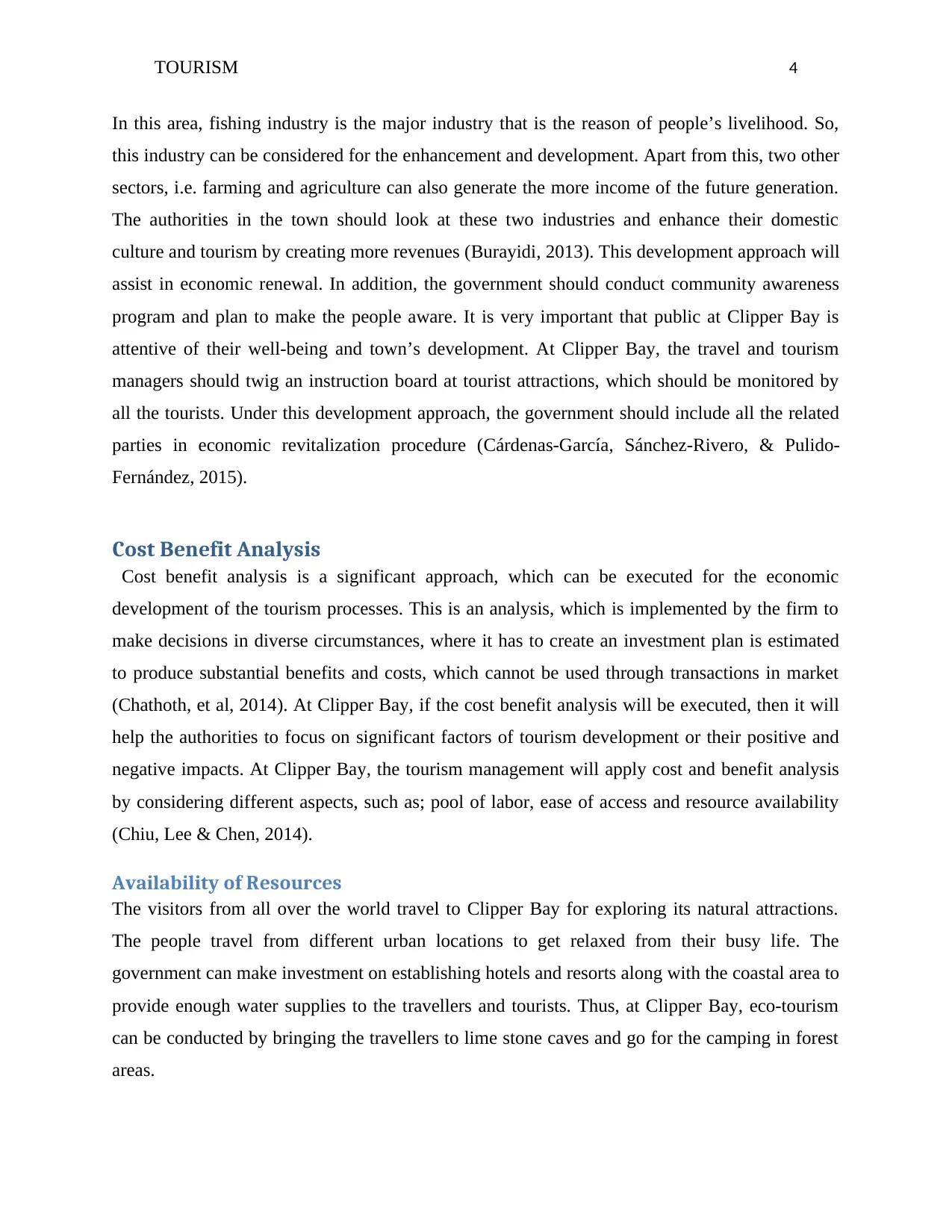
TOURISM 4
In this area, fishing industry is the major industry that is the reason of people’s livelihood. So,
this industry can be considered for the enhancement and development. Apart from this, two other
sectors, i.e. farming and agriculture can also generate the more income of the future generation.
The authorities in the town should look at these two industries and enhance their domestic
culture and tourism by creating more revenues (Burayidi, 2013). This development approach will
assist in economic renewal. In addition, the government should conduct community awareness
program and plan to make the people aware. It is very important that public at Clipper Bay is
attentive of their well-being and town’s development. At Clipper Bay, the travel and tourism
managers should twig an instruction board at tourist attractions, which should be monitored by
all the tourists. Under this development approach, the government should include all the related
parties in economic revitalization procedure (Cárdenas-García, Sánchez-Rivero, & Pulido-
Fernández, 2015).
Cost Benefit Analysis
Cost benefit analysis is a significant approach, which can be executed for the economic
development of the tourism processes. This is an analysis, which is implemented by the firm to
make decisions in diverse circumstances, where it has to create an investment plan is estimated
to produce substantial benefits and costs, which cannot be used through transactions in market
(Chathoth, et al, 2014). At Clipper Bay, if the cost benefit analysis will be executed, then it will
help the authorities to focus on significant factors of tourism development or their positive and
negative impacts. At Clipper Bay, the tourism management will apply cost and benefit analysis
by considering different aspects, such as; pool of labor, ease of access and resource availability
(Chiu, Lee & Chen, 2014).
Availability of Resources
The visitors from all over the world travel to Clipper Bay for exploring its natural attractions.
The people travel from different urban locations to get relaxed from their busy life. The
government can make investment on establishing hotels and resorts along with the coastal area to
provide enough water supplies to the travellers and tourists. Thus, at Clipper Bay, eco-tourism
can be conducted by bringing the travellers to lime stone caves and go for the camping in forest
areas.
In this area, fishing industry is the major industry that is the reason of people’s livelihood. So,
this industry can be considered for the enhancement and development. Apart from this, two other
sectors, i.e. farming and agriculture can also generate the more income of the future generation.
The authorities in the town should look at these two industries and enhance their domestic
culture and tourism by creating more revenues (Burayidi, 2013). This development approach will
assist in economic renewal. In addition, the government should conduct community awareness
program and plan to make the people aware. It is very important that public at Clipper Bay is
attentive of their well-being and town’s development. At Clipper Bay, the travel and tourism
managers should twig an instruction board at tourist attractions, which should be monitored by
all the tourists. Under this development approach, the government should include all the related
parties in economic revitalization procedure (Cárdenas-García, Sánchez-Rivero, & Pulido-
Fernández, 2015).
Cost Benefit Analysis
Cost benefit analysis is a significant approach, which can be executed for the economic
development of the tourism processes. This is an analysis, which is implemented by the firm to
make decisions in diverse circumstances, where it has to create an investment plan is estimated
to produce substantial benefits and costs, which cannot be used through transactions in market
(Chathoth, et al, 2014). At Clipper Bay, if the cost benefit analysis will be executed, then it will
help the authorities to focus on significant factors of tourism development or their positive and
negative impacts. At Clipper Bay, the tourism management will apply cost and benefit analysis
by considering different aspects, such as; pool of labor, ease of access and resource availability
(Chiu, Lee & Chen, 2014).
Availability of Resources
The visitors from all over the world travel to Clipper Bay for exploring its natural attractions.
The people travel from different urban locations to get relaxed from their busy life. The
government can make investment on establishing hotels and resorts along with the coastal area to
provide enough water supplies to the travellers and tourists. Thus, at Clipper Bay, eco-tourism
can be conducted by bringing the travellers to lime stone caves and go for the camping in forest
areas.
Secure Best Marks with AI Grader
Need help grading? Try our AI Grader for instant feedback on your assignments.
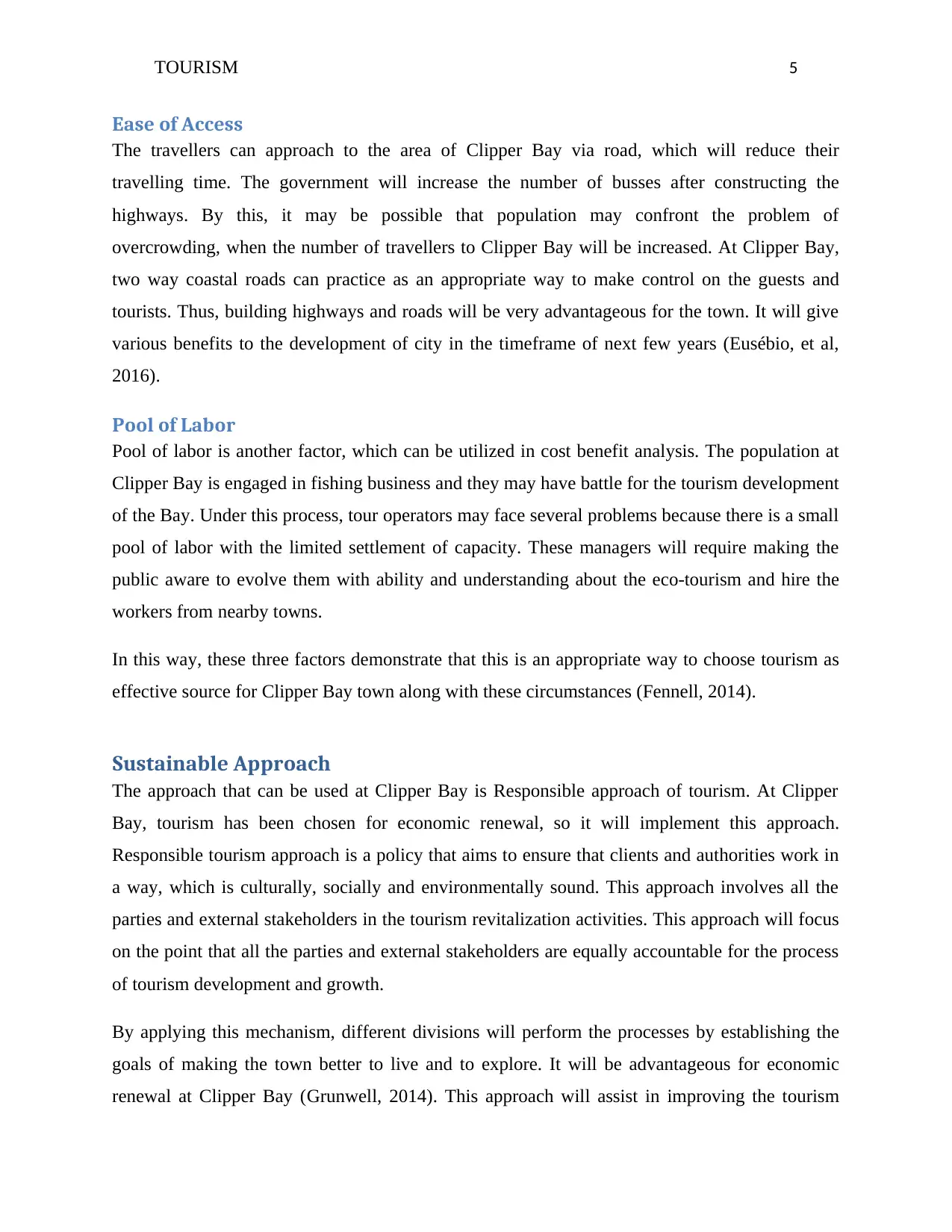
TOURISM 5
Ease of Access
The travellers can approach to the area of Clipper Bay via road, which will reduce their
travelling time. The government will increase the number of busses after constructing the
highways. By this, it may be possible that population may confront the problem of
overcrowding, when the number of travellers to Clipper Bay will be increased. At Clipper Bay,
two way coastal roads can practice as an appropriate way to make control on the guests and
tourists. Thus, building highways and roads will be very advantageous for the town. It will give
various benefits to the development of city in the timeframe of next few years (Eusébio, et al,
2016).
Pool of Labor
Pool of labor is another factor, which can be utilized in cost benefit analysis. The population at
Clipper Bay is engaged in fishing business and they may have battle for the tourism development
of the Bay. Under this process, tour operators may face several problems because there is a small
pool of labor with the limited settlement of capacity. These managers will require making the
public aware to evolve them with ability and understanding about the eco-tourism and hire the
workers from nearby towns.
In this way, these three factors demonstrate that this is an appropriate way to choose tourism as
effective source for Clipper Bay town along with these circumstances (Fennell, 2014).
Sustainable Approach
The approach that can be used at Clipper Bay is Responsible approach of tourism. At Clipper
Bay, tourism has been chosen for economic renewal, so it will implement this approach.
Responsible tourism approach is a policy that aims to ensure that clients and authorities work in
a way, which is culturally, socially and environmentally sound. This approach involves all the
parties and external stakeholders in the tourism revitalization activities. This approach will focus
on the point that all the parties and external stakeholders are equally accountable for the process
of tourism development and growth.
By applying this mechanism, different divisions will perform the processes by establishing the
goals of making the town better to live and to explore. It will be advantageous for economic
renewal at Clipper Bay (Grunwell, 2014). This approach will assist in improving the tourism
Ease of Access
The travellers can approach to the area of Clipper Bay via road, which will reduce their
travelling time. The government will increase the number of busses after constructing the
highways. By this, it may be possible that population may confront the problem of
overcrowding, when the number of travellers to Clipper Bay will be increased. At Clipper Bay,
two way coastal roads can practice as an appropriate way to make control on the guests and
tourists. Thus, building highways and roads will be very advantageous for the town. It will give
various benefits to the development of city in the timeframe of next few years (Eusébio, et al,
2016).
Pool of Labor
Pool of labor is another factor, which can be utilized in cost benefit analysis. The population at
Clipper Bay is engaged in fishing business and they may have battle for the tourism development
of the Bay. Under this process, tour operators may face several problems because there is a small
pool of labor with the limited settlement of capacity. These managers will require making the
public aware to evolve them with ability and understanding about the eco-tourism and hire the
workers from nearby towns.
In this way, these three factors demonstrate that this is an appropriate way to choose tourism as
effective source for Clipper Bay town along with these circumstances (Fennell, 2014).
Sustainable Approach
The approach that can be used at Clipper Bay is Responsible approach of tourism. At Clipper
Bay, tourism has been chosen for economic renewal, so it will implement this approach.
Responsible tourism approach is a policy that aims to ensure that clients and authorities work in
a way, which is culturally, socially and environmentally sound. This approach involves all the
parties and external stakeholders in the tourism revitalization activities. This approach will focus
on the point that all the parties and external stakeholders are equally accountable for the process
of tourism development and growth.
By applying this mechanism, different divisions will perform the processes by establishing the
goals of making the town better to live and to explore. It will be advantageous for economic
renewal at Clipper Bay (Grunwell, 2014). This approach will assist in improving the tourism
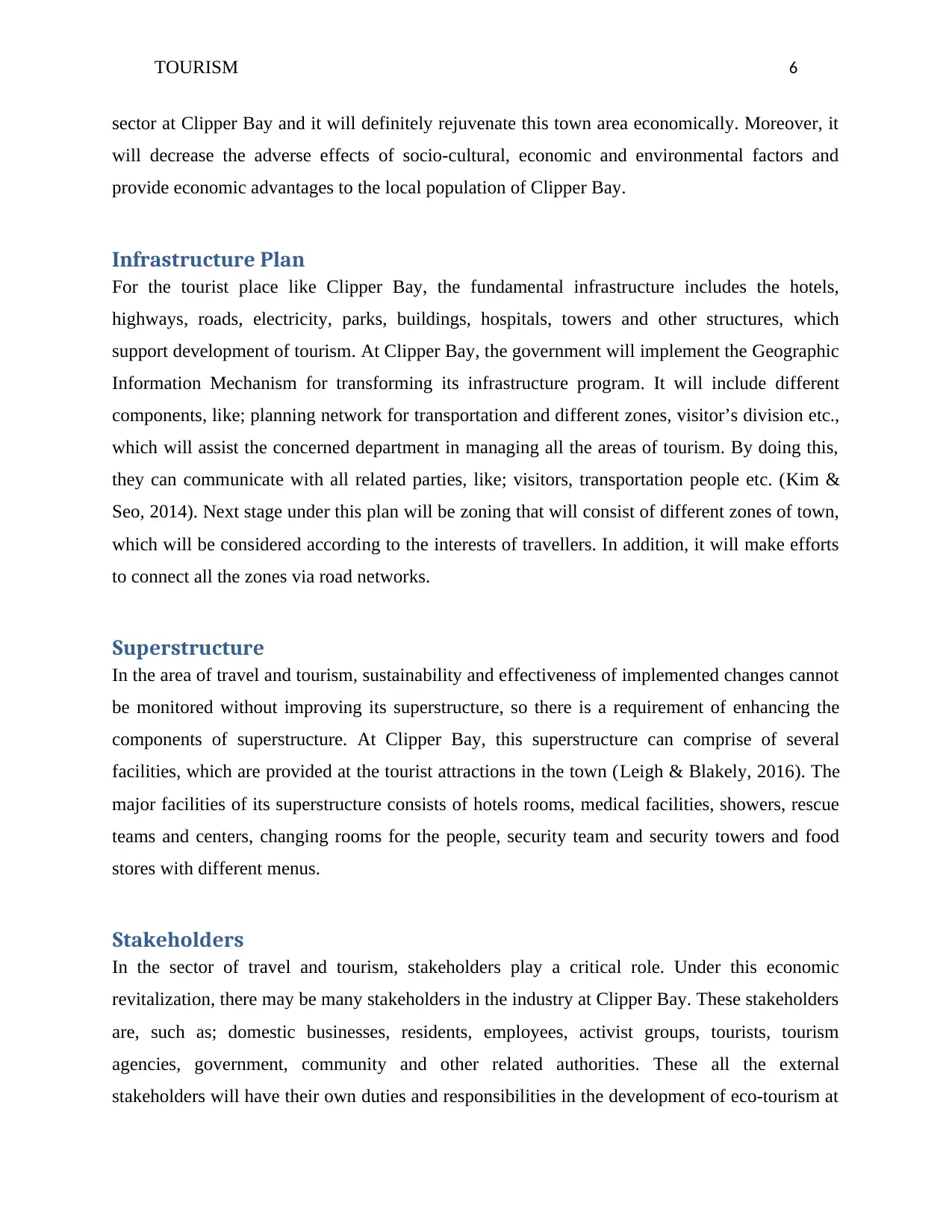
TOURISM 6
sector at Clipper Bay and it will definitely rejuvenate this town area economically. Moreover, it
will decrease the adverse effects of socio-cultural, economic and environmental factors and
provide economic advantages to the local population of Clipper Bay.
Infrastructure Plan
For the tourist place like Clipper Bay, the fundamental infrastructure includes the hotels,
highways, roads, electricity, parks, buildings, hospitals, towers and other structures, which
support development of tourism. At Clipper Bay, the government will implement the Geographic
Information Mechanism for transforming its infrastructure program. It will include different
components, like; planning network for transportation and different zones, visitor’s division etc.,
which will assist the concerned department in managing all the areas of tourism. By doing this,
they can communicate with all related parties, like; visitors, transportation people etc. (Kim &
Seo, 2014). Next stage under this plan will be zoning that will consist of different zones of town,
which will be considered according to the interests of travellers. In addition, it will make efforts
to connect all the zones via road networks.
Superstructure
In the area of travel and tourism, sustainability and effectiveness of implemented changes cannot
be monitored without improving its superstructure, so there is a requirement of enhancing the
components of superstructure. At Clipper Bay, this superstructure can comprise of several
facilities, which are provided at the tourist attractions in the town (Leigh & Blakely, 2016). The
major facilities of its superstructure consists of hotels rooms, medical facilities, showers, rescue
teams and centers, changing rooms for the people, security team and security towers and food
stores with different menus.
Stakeholders
In the sector of travel and tourism, stakeholders play a critical role. Under this economic
revitalization, there may be many stakeholders in the industry at Clipper Bay. These stakeholders
are, such as; domestic businesses, residents, employees, activist groups, tourists, tourism
agencies, government, community and other related authorities. These all the external
stakeholders will have their own duties and responsibilities in the development of eco-tourism at
sector at Clipper Bay and it will definitely rejuvenate this town area economically. Moreover, it
will decrease the adverse effects of socio-cultural, economic and environmental factors and
provide economic advantages to the local population of Clipper Bay.
Infrastructure Plan
For the tourist place like Clipper Bay, the fundamental infrastructure includes the hotels,
highways, roads, electricity, parks, buildings, hospitals, towers and other structures, which
support development of tourism. At Clipper Bay, the government will implement the Geographic
Information Mechanism for transforming its infrastructure program. It will include different
components, like; planning network for transportation and different zones, visitor’s division etc.,
which will assist the concerned department in managing all the areas of tourism. By doing this,
they can communicate with all related parties, like; visitors, transportation people etc. (Kim &
Seo, 2014). Next stage under this plan will be zoning that will consist of different zones of town,
which will be considered according to the interests of travellers. In addition, it will make efforts
to connect all the zones via road networks.
Superstructure
In the area of travel and tourism, sustainability and effectiveness of implemented changes cannot
be monitored without improving its superstructure, so there is a requirement of enhancing the
components of superstructure. At Clipper Bay, this superstructure can comprise of several
facilities, which are provided at the tourist attractions in the town (Leigh & Blakely, 2016). The
major facilities of its superstructure consists of hotels rooms, medical facilities, showers, rescue
teams and centers, changing rooms for the people, security team and security towers and food
stores with different menus.
Stakeholders
In the sector of travel and tourism, stakeholders play a critical role. Under this economic
revitalization, there may be many stakeholders in the industry at Clipper Bay. These stakeholders
are, such as; domestic businesses, residents, employees, activist groups, tourists, tourism
agencies, government, community and other related authorities. These all the external
stakeholders will have their own duties and responsibilities in the development of eco-tourism at
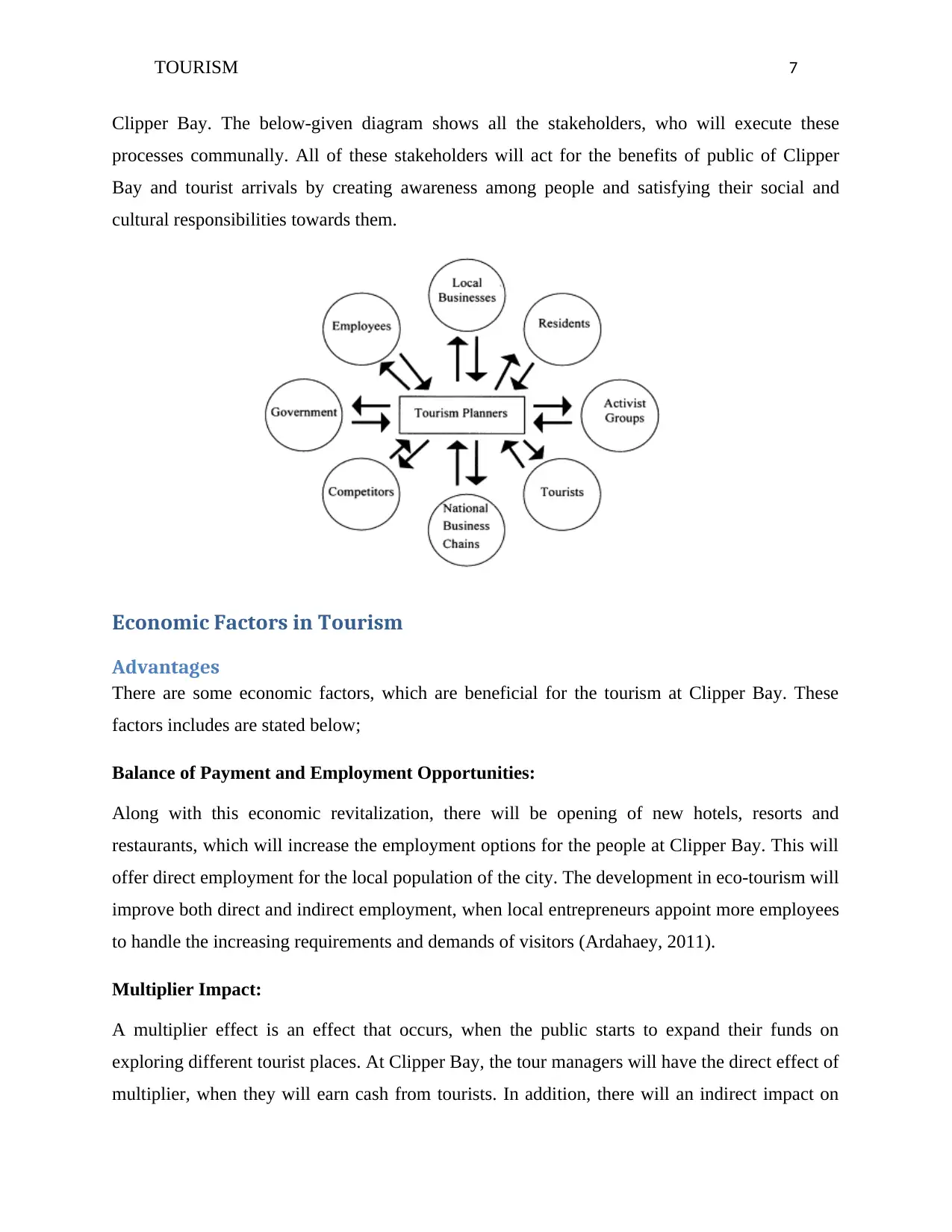
TOURISM 7
Clipper Bay. The below-given diagram shows all the stakeholders, who will execute these
processes communally. All of these stakeholders will act for the benefits of public of Clipper
Bay and tourist arrivals by creating awareness among people and satisfying their social and
cultural responsibilities towards them.
Economic Factors in Tourism
Advantages
There are some economic factors, which are beneficial for the tourism at Clipper Bay. These
factors includes are stated below;
Balance of Payment and Employment Opportunities:
Along with this economic revitalization, there will be opening of new hotels, resorts and
restaurants, which will increase the employment options for the people at Clipper Bay. This will
offer direct employment for the local population of the city. The development in eco-tourism will
improve both direct and indirect employment, when local entrepreneurs appoint more employees
to handle the increasing requirements and demands of visitors (Ardahaey, 2011).
Multiplier Impact:
A multiplier effect is an effect that occurs, when the public starts to expand their funds on
exploring different tourist places. At Clipper Bay, the tour managers will have the direct effect of
multiplier, when they will earn cash from tourists. In addition, there will an indirect impact on
Clipper Bay. The below-given diagram shows all the stakeholders, who will execute these
processes communally. All of these stakeholders will act for the benefits of public of Clipper
Bay and tourist arrivals by creating awareness among people and satisfying their social and
cultural responsibilities towards them.
Economic Factors in Tourism
Advantages
There are some economic factors, which are beneficial for the tourism at Clipper Bay. These
factors includes are stated below;
Balance of Payment and Employment Opportunities:
Along with this economic revitalization, there will be opening of new hotels, resorts and
restaurants, which will increase the employment options for the people at Clipper Bay. This will
offer direct employment for the local population of the city. The development in eco-tourism will
improve both direct and indirect employment, when local entrepreneurs appoint more employees
to handle the increasing requirements and demands of visitors (Ardahaey, 2011).
Multiplier Impact:
A multiplier effect is an effect that occurs, when the public starts to expand their funds on
exploring different tourist places. At Clipper Bay, the tour managers will have the direct effect of
multiplier, when they will earn cash from tourists. In addition, there will an indirect impact on
Paraphrase This Document
Need a fresh take? Get an instant paraphrase of this document with our AI Paraphraser
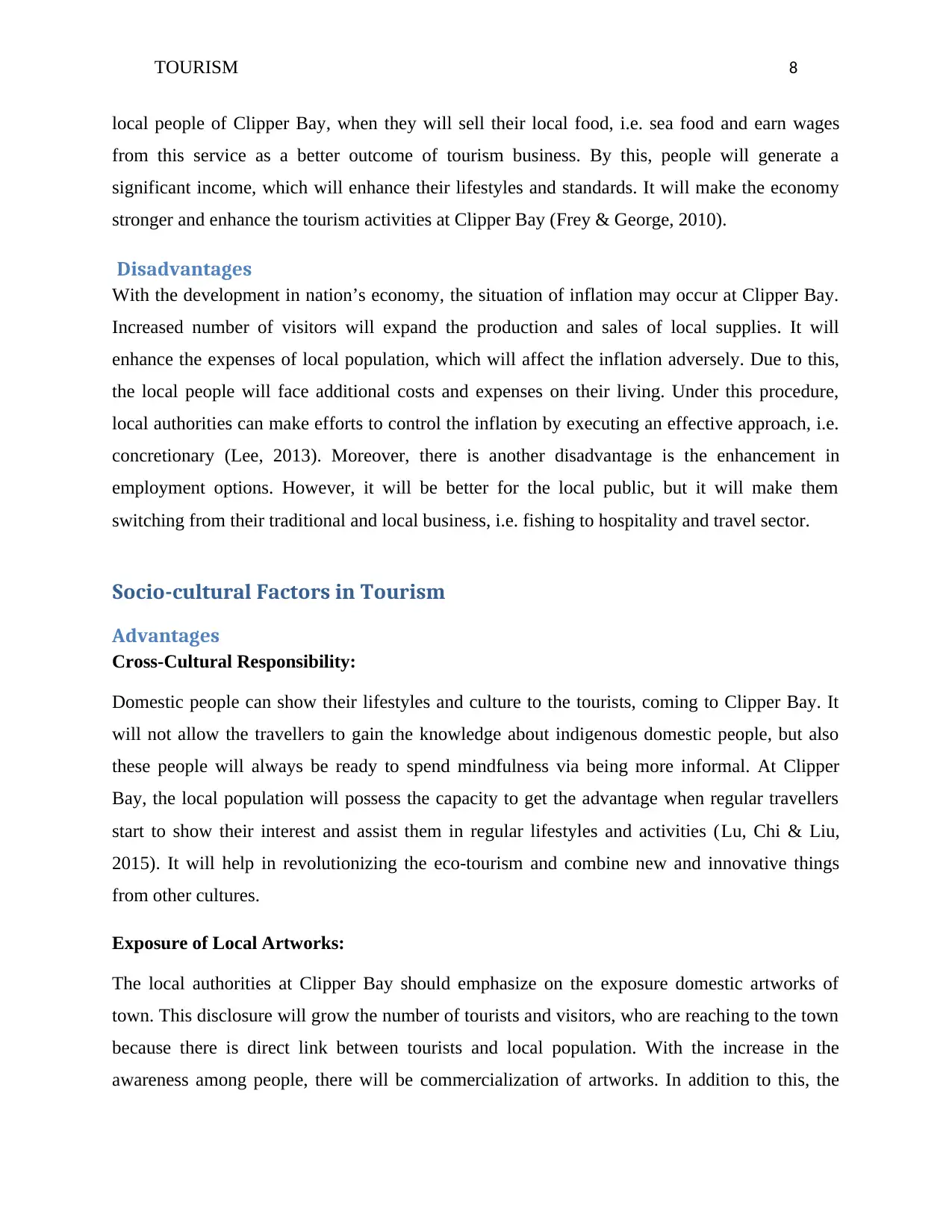
TOURISM 8
local people of Clipper Bay, when they will sell their local food, i.e. sea food and earn wages
from this service as a better outcome of tourism business. By this, people will generate a
significant income, which will enhance their lifestyles and standards. It will make the economy
stronger and enhance the tourism activities at Clipper Bay (Frey & George, 2010).
Disadvantages
With the development in nation’s economy, the situation of inflation may occur at Clipper Bay.
Increased number of visitors will expand the production and sales of local supplies. It will
enhance the expenses of local population, which will affect the inflation adversely. Due to this,
the local people will face additional costs and expenses on their living. Under this procedure,
local authorities can make efforts to control the inflation by executing an effective approach, i.e.
concretionary (Lee, 2013). Moreover, there is another disadvantage is the enhancement in
employment options. However, it will be better for the local public, but it will make them
switching from their traditional and local business, i.e. fishing to hospitality and travel sector.
Socio-cultural Factors in Tourism
Advantages
Cross-Cultural Responsibility:
Domestic people can show their lifestyles and culture to the tourists, coming to Clipper Bay. It
will not allow the travellers to gain the knowledge about indigenous domestic people, but also
these people will always be ready to spend mindfulness via being more informal. At Clipper
Bay, the local population will possess the capacity to get the advantage when regular travellers
start to show their interest and assist them in regular lifestyles and activities (Lu, Chi & Liu,
2015). It will help in revolutionizing the eco-tourism and combine new and innovative things
from other cultures.
Exposure of Local Artworks:
The local authorities at Clipper Bay should emphasize on the exposure domestic artworks of
town. This disclosure will grow the number of tourists and visitors, who are reaching to the town
because there is direct link between tourists and local population. With the increase in the
awareness among people, there will be commercialization of artworks. In addition to this, the
local people of Clipper Bay, when they will sell their local food, i.e. sea food and earn wages
from this service as a better outcome of tourism business. By this, people will generate a
significant income, which will enhance their lifestyles and standards. It will make the economy
stronger and enhance the tourism activities at Clipper Bay (Frey & George, 2010).
Disadvantages
With the development in nation’s economy, the situation of inflation may occur at Clipper Bay.
Increased number of visitors will expand the production and sales of local supplies. It will
enhance the expenses of local population, which will affect the inflation adversely. Due to this,
the local people will face additional costs and expenses on their living. Under this procedure,
local authorities can make efforts to control the inflation by executing an effective approach, i.e.
concretionary (Lee, 2013). Moreover, there is another disadvantage is the enhancement in
employment options. However, it will be better for the local public, but it will make them
switching from their traditional and local business, i.e. fishing to hospitality and travel sector.
Socio-cultural Factors in Tourism
Advantages
Cross-Cultural Responsibility:
Domestic people can show their lifestyles and culture to the tourists, coming to Clipper Bay. It
will not allow the travellers to gain the knowledge about indigenous domestic people, but also
these people will always be ready to spend mindfulness via being more informal. At Clipper
Bay, the local population will possess the capacity to get the advantage when regular travellers
start to show their interest and assist them in regular lifestyles and activities (Lu, Chi & Liu,
2015). It will help in revolutionizing the eco-tourism and combine new and innovative things
from other cultures.
Exposure of Local Artworks:
The local authorities at Clipper Bay should emphasize on the exposure domestic artworks of
town. This disclosure will grow the number of tourists and visitors, who are reaching to the town
because there is direct link between tourists and local population. With the increase in the
awareness among people, there will be commercialization of artworks. In addition to this, the
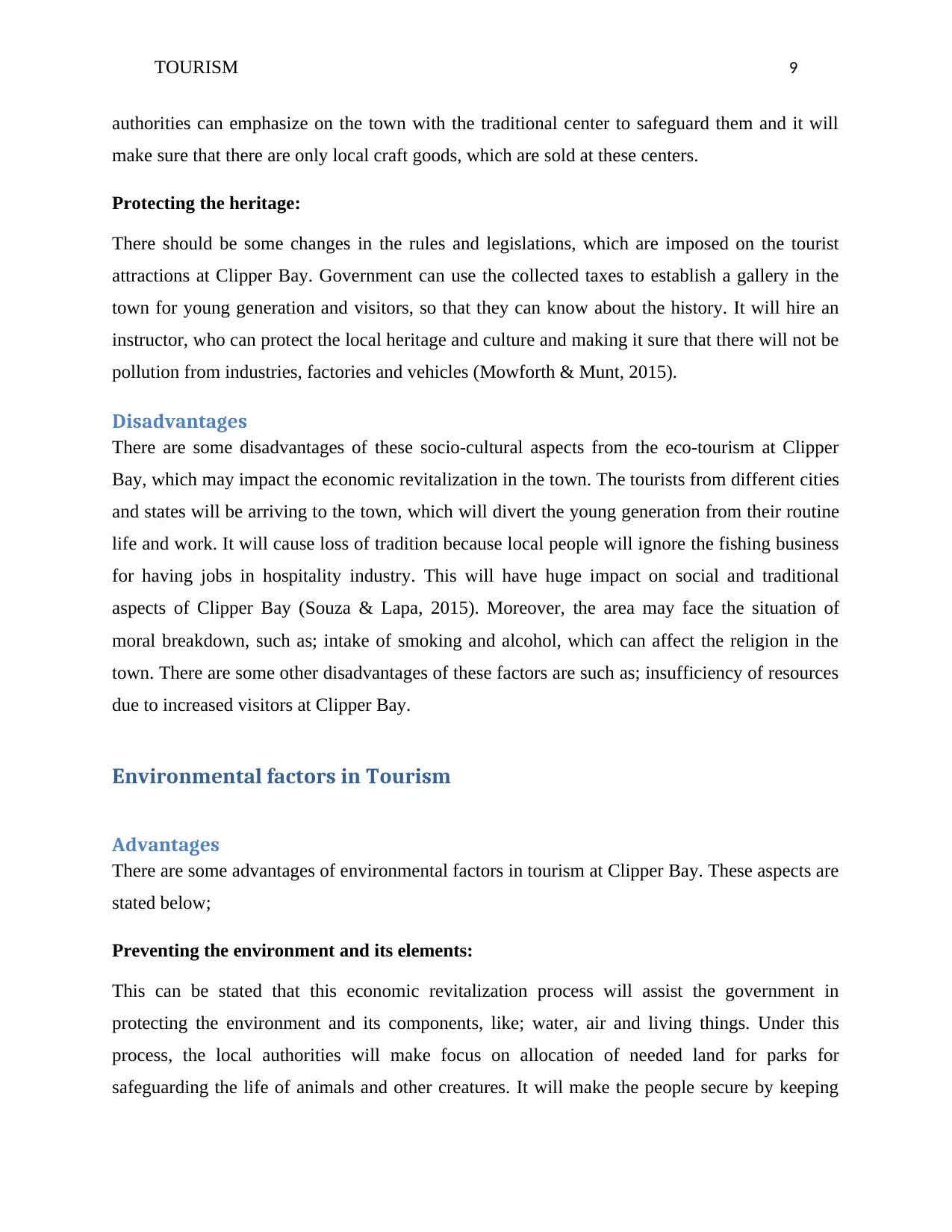
TOURISM 9
authorities can emphasize on the town with the traditional center to safeguard them and it will
make sure that there are only local craft goods, which are sold at these centers.
Protecting the heritage:
There should be some changes in the rules and legislations, which are imposed on the tourist
attractions at Clipper Bay. Government can use the collected taxes to establish a gallery in the
town for young generation and visitors, so that they can know about the history. It will hire an
instructor, who can protect the local heritage and culture and making it sure that there will not be
pollution from industries, factories and vehicles (Mowforth & Munt, 2015).
Disadvantages
There are some disadvantages of these socio-cultural aspects from the eco-tourism at Clipper
Bay, which may impact the economic revitalization in the town. The tourists from different cities
and states will be arriving to the town, which will divert the young generation from their routine
life and work. It will cause loss of tradition because local people will ignore the fishing business
for having jobs in hospitality industry. This will have huge impact on social and traditional
aspects of Clipper Bay (Souza & Lapa, 2015). Moreover, the area may face the situation of
moral breakdown, such as; intake of smoking and alcohol, which can affect the religion in the
town. There are some other disadvantages of these factors are such as; insufficiency of resources
due to increased visitors at Clipper Bay.
Environmental factors in Tourism
Advantages
There are some advantages of environmental factors in tourism at Clipper Bay. These aspects are
stated below;
Preventing the environment and its elements:
This can be stated that this economic revitalization process will assist the government in
protecting the environment and its components, like; water, air and living things. Under this
process, the local authorities will make focus on allocation of needed land for parks for
safeguarding the life of animals and other creatures. It will make the people secure by keeping
authorities can emphasize on the town with the traditional center to safeguard them and it will
make sure that there are only local craft goods, which are sold at these centers.
Protecting the heritage:
There should be some changes in the rules and legislations, which are imposed on the tourist
attractions at Clipper Bay. Government can use the collected taxes to establish a gallery in the
town for young generation and visitors, so that they can know about the history. It will hire an
instructor, who can protect the local heritage and culture and making it sure that there will not be
pollution from industries, factories and vehicles (Mowforth & Munt, 2015).
Disadvantages
There are some disadvantages of these socio-cultural aspects from the eco-tourism at Clipper
Bay, which may impact the economic revitalization in the town. The tourists from different cities
and states will be arriving to the town, which will divert the young generation from their routine
life and work. It will cause loss of tradition because local people will ignore the fishing business
for having jobs in hospitality industry. This will have huge impact on social and traditional
aspects of Clipper Bay (Souza & Lapa, 2015). Moreover, the area may face the situation of
moral breakdown, such as; intake of smoking and alcohol, which can affect the religion in the
town. There are some other disadvantages of these factors are such as; insufficiency of resources
due to increased visitors at Clipper Bay.
Environmental factors in Tourism
Advantages
There are some advantages of environmental factors in tourism at Clipper Bay. These aspects are
stated below;
Preventing the environment and its elements:
This can be stated that this economic revitalization process will assist the government in
protecting the environment and its components, like; water, air and living things. Under this
process, the local authorities will make focus on allocation of needed land for parks for
safeguarding the life of animals and other creatures. It will make the people secure by keeping
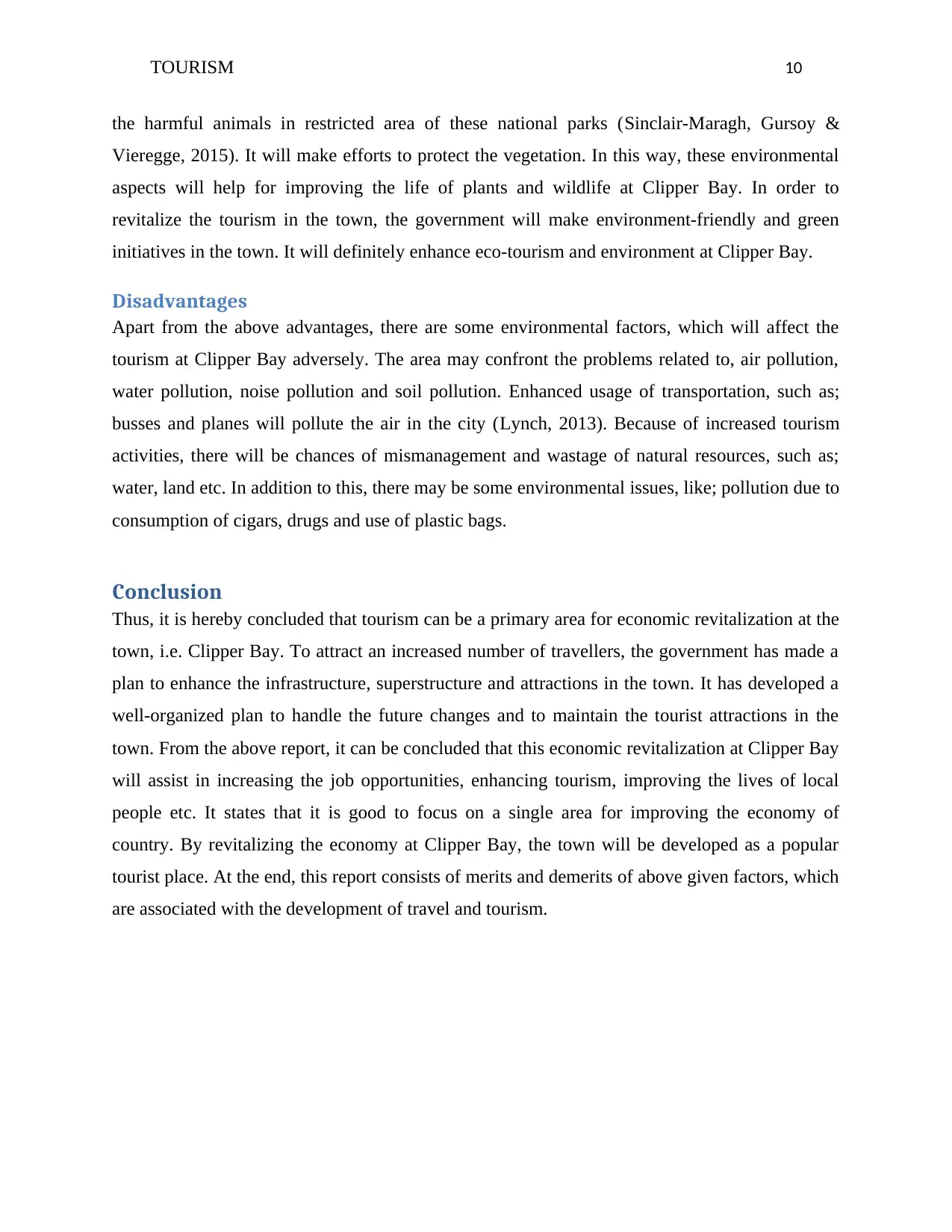
TOURISM 10
the harmful animals in restricted area of these national parks (Sinclair-Maragh, Gursoy &
Vieregge, 2015). It will make efforts to protect the vegetation. In this way, these environmental
aspects will help for improving the life of plants and wildlife at Clipper Bay. In order to
revitalize the tourism in the town, the government will make environment-friendly and green
initiatives in the town. It will definitely enhance eco-tourism and environment at Clipper Bay.
Disadvantages
Apart from the above advantages, there are some environmental factors, which will affect the
tourism at Clipper Bay adversely. The area may confront the problems related to, air pollution,
water pollution, noise pollution and soil pollution. Enhanced usage of transportation, such as;
busses and planes will pollute the air in the city (Lynch, 2013). Because of increased tourism
activities, there will be chances of mismanagement and wastage of natural resources, such as;
water, land etc. In addition to this, there may be some environmental issues, like; pollution due to
consumption of cigars, drugs and use of plastic bags.
Conclusion
Thus, it is hereby concluded that tourism can be a primary area for economic revitalization at the
town, i.e. Clipper Bay. To attract an increased number of travellers, the government has made a
plan to enhance the infrastructure, superstructure and attractions in the town. It has developed a
well-organized plan to handle the future changes and to maintain the tourist attractions in the
town. From the above report, it can be concluded that this economic revitalization at Clipper Bay
will assist in increasing the job opportunities, enhancing tourism, improving the lives of local
people etc. It states that it is good to focus on a single area for improving the economy of
country. By revitalizing the economy at Clipper Bay, the town will be developed as a popular
tourist place. At the end, this report consists of merits and demerits of above given factors, which
are associated with the development of travel and tourism.
the harmful animals in restricted area of these national parks (Sinclair-Maragh, Gursoy &
Vieregge, 2015). It will make efforts to protect the vegetation. In this way, these environmental
aspects will help for improving the life of plants and wildlife at Clipper Bay. In order to
revitalize the tourism in the town, the government will make environment-friendly and green
initiatives in the town. It will definitely enhance eco-tourism and environment at Clipper Bay.
Disadvantages
Apart from the above advantages, there are some environmental factors, which will affect the
tourism at Clipper Bay adversely. The area may confront the problems related to, air pollution,
water pollution, noise pollution and soil pollution. Enhanced usage of transportation, such as;
busses and planes will pollute the air in the city (Lynch, 2013). Because of increased tourism
activities, there will be chances of mismanagement and wastage of natural resources, such as;
water, land etc. In addition to this, there may be some environmental issues, like; pollution due to
consumption of cigars, drugs and use of plastic bags.
Conclusion
Thus, it is hereby concluded that tourism can be a primary area for economic revitalization at the
town, i.e. Clipper Bay. To attract an increased number of travellers, the government has made a
plan to enhance the infrastructure, superstructure and attractions in the town. It has developed a
well-organized plan to handle the future changes and to maintain the tourist attractions in the
town. From the above report, it can be concluded that this economic revitalization at Clipper Bay
will assist in increasing the job opportunities, enhancing tourism, improving the lives of local
people etc. It states that it is good to focus on a single area for improving the economy of
country. By revitalizing the economy at Clipper Bay, the town will be developed as a popular
tourist place. At the end, this report consists of merits and demerits of above given factors, which
are associated with the development of travel and tourism.
Secure Best Marks with AI Grader
Need help grading? Try our AI Grader for instant feedback on your assignments.
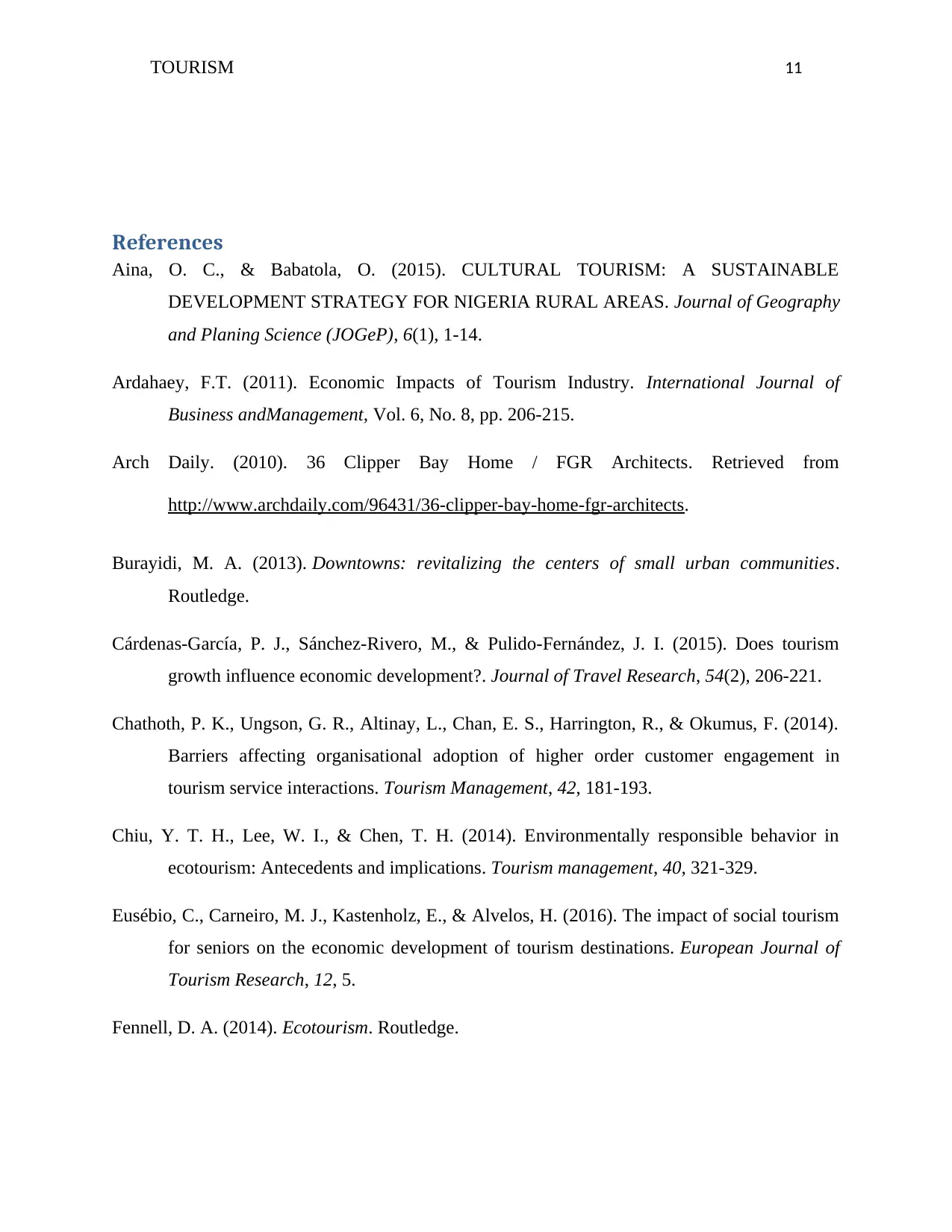
TOURISM 11
References
Aina, O. C., & Babatola, O. (2015). CULTURAL TOURISM: A SUSTAINABLE
DEVELOPMENT STRATEGY FOR NIGERIA RURAL AREAS. Journal of Geography
and Planing Science (JOGeP), 6(1), 1-14.
Ardahaey, F.T. (2011). Economic Impacts of Tourism Industry. International Journal of
Business andManagement, Vol. 6, No. 8, pp. 206-215.
Arch Daily. (2010). 36 Clipper Bay Home / FGR Architects. Retrieved from
http://www.archdaily.com/96431/36-clipper-bay-home-fgr-architects.
Burayidi, M. A. (2013). Downtowns: revitalizing the centers of small urban communities.
Routledge.
Cárdenas-García, P. J., Sánchez-Rivero, M., & Pulido-Fernández, J. I. (2015). Does tourism
growth influence economic development?. Journal of Travel Research, 54(2), 206-221.
Chathoth, P. K., Ungson, G. R., Altinay, L., Chan, E. S., Harrington, R., & Okumus, F. (2014).
Barriers affecting organisational adoption of higher order customer engagement in
tourism service interactions. Tourism Management, 42, 181-193.
Chiu, Y. T. H., Lee, W. I., & Chen, T. H. (2014). Environmentally responsible behavior in
ecotourism: Antecedents and implications. Tourism management, 40, 321-329.
Eusébio, C., Carneiro, M. J., Kastenholz, E., & Alvelos, H. (2016). The impact of social tourism
for seniors on the economic development of tourism destinations. European Journal of
Tourism Research, 12, 5.
Fennell, D. A. (2014). Ecotourism. Routledge.
References
Aina, O. C., & Babatola, O. (2015). CULTURAL TOURISM: A SUSTAINABLE
DEVELOPMENT STRATEGY FOR NIGERIA RURAL AREAS. Journal of Geography
and Planing Science (JOGeP), 6(1), 1-14.
Ardahaey, F.T. (2011). Economic Impacts of Tourism Industry. International Journal of
Business andManagement, Vol. 6, No. 8, pp. 206-215.
Arch Daily. (2010). 36 Clipper Bay Home / FGR Architects. Retrieved from
http://www.archdaily.com/96431/36-clipper-bay-home-fgr-architects.
Burayidi, M. A. (2013). Downtowns: revitalizing the centers of small urban communities.
Routledge.
Cárdenas-García, P. J., Sánchez-Rivero, M., & Pulido-Fernández, J. I. (2015). Does tourism
growth influence economic development?. Journal of Travel Research, 54(2), 206-221.
Chathoth, P. K., Ungson, G. R., Altinay, L., Chan, E. S., Harrington, R., & Okumus, F. (2014).
Barriers affecting organisational adoption of higher order customer engagement in
tourism service interactions. Tourism Management, 42, 181-193.
Chiu, Y. T. H., Lee, W. I., & Chen, T. H. (2014). Environmentally responsible behavior in
ecotourism: Antecedents and implications. Tourism management, 40, 321-329.
Eusébio, C., Carneiro, M. J., Kastenholz, E., & Alvelos, H. (2016). The impact of social tourism
for seniors on the economic development of tourism destinations. European Journal of
Tourism Research, 12, 5.
Fennell, D. A. (2014). Ecotourism. Routledge.
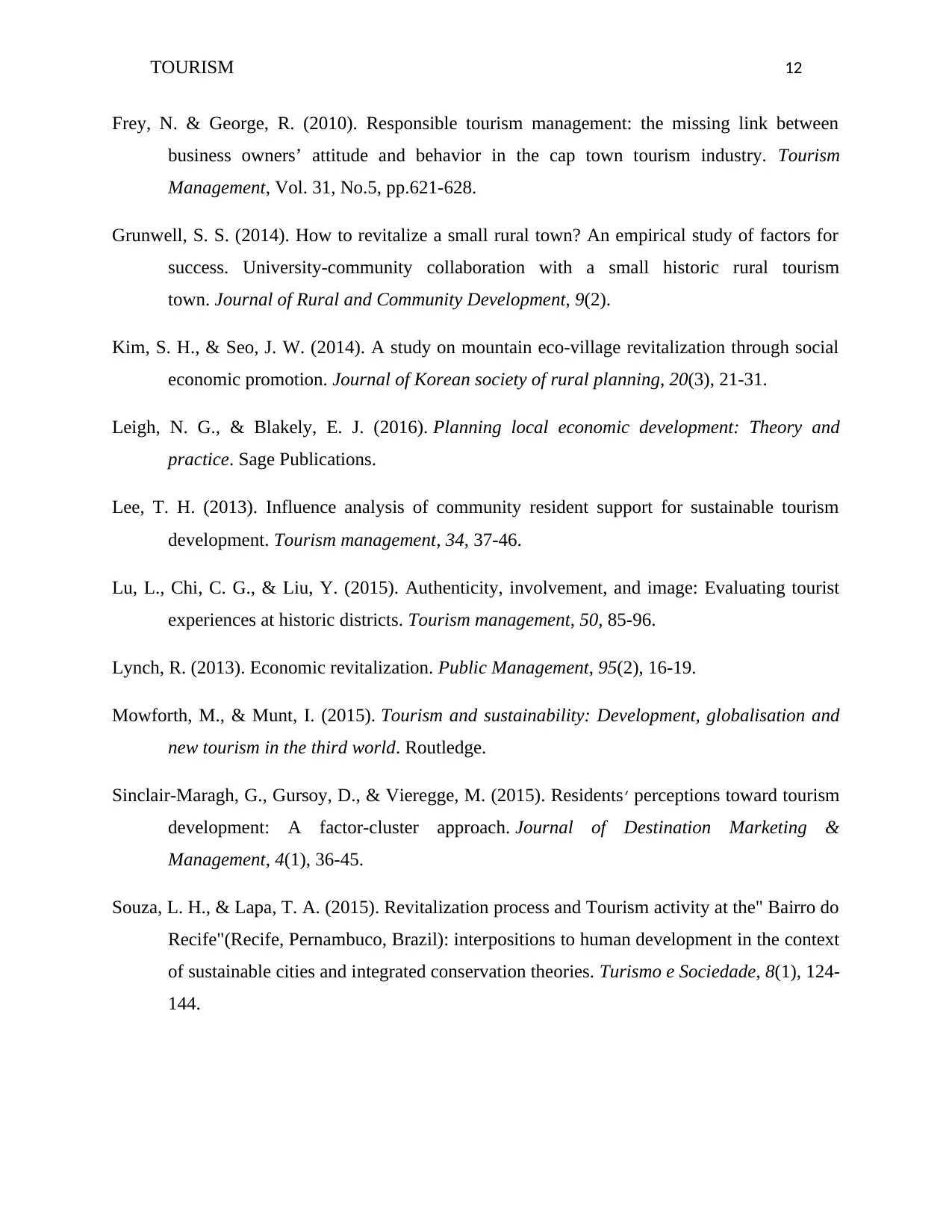
TOURISM 12
Frey, N. & George, R. (2010). Responsible tourism management: the missing link between
business owners’ attitude and behavior in the cap town tourism industry. Tourism
Management, Vol. 31, No.5, pp.621-628.
Grunwell, S. S. (2014). How to revitalize a small rural town? An empirical study of factors for
success. University-community collaboration with a small historic rural tourism
town. Journal of Rural and Community Development, 9(2).
Kim, S. H., & Seo, J. W. (2014). A study on mountain eco-village revitalization through social
economic promotion. Journal of Korean society of rural planning, 20(3), 21-31.
Leigh, N. G., & Blakely, E. J. (2016). Planning local economic development: Theory and
practice. Sage Publications.
Lee, T. H. (2013). Influence analysis of community resident support for sustainable tourism
development. Tourism management, 34, 37-46.
Lu, L., Chi, C. G., & Liu, Y. (2015). Authenticity, involvement, and image: Evaluating tourist
experiences at historic districts. Tourism management, 50, 85-96.
Lynch, R. (2013). Economic revitalization. Public Management, 95(2), 16-19.
Mowforth, M., & Munt, I. (2015). Tourism and sustainability: Development, globalisation and
new tourism in the third world. Routledge.
Sinclair-Maragh, G., Gursoy, D., & Vieregge, M. (2015). Residents׳ perceptions toward tourism
development: A factor-cluster approach. Journal of Destination Marketing &
Management, 4(1), 36-45.
Souza, L. H., & Lapa, T. A. (2015). Revitalization process and Tourism activity at the" Bairro do
Recife"(Recife, Pernambuco, Brazil): interpositions to human development in the context
of sustainable cities and integrated conservation theories. Turismo e Sociedade, 8(1), 124-
144.
Frey, N. & George, R. (2010). Responsible tourism management: the missing link between
business owners’ attitude and behavior in the cap town tourism industry. Tourism
Management, Vol. 31, No.5, pp.621-628.
Grunwell, S. S. (2014). How to revitalize a small rural town? An empirical study of factors for
success. University-community collaboration with a small historic rural tourism
town. Journal of Rural and Community Development, 9(2).
Kim, S. H., & Seo, J. W. (2014). A study on mountain eco-village revitalization through social
economic promotion. Journal of Korean society of rural planning, 20(3), 21-31.
Leigh, N. G., & Blakely, E. J. (2016). Planning local economic development: Theory and
practice. Sage Publications.
Lee, T. H. (2013). Influence analysis of community resident support for sustainable tourism
development. Tourism management, 34, 37-46.
Lu, L., Chi, C. G., & Liu, Y. (2015). Authenticity, involvement, and image: Evaluating tourist
experiences at historic districts. Tourism management, 50, 85-96.
Lynch, R. (2013). Economic revitalization. Public Management, 95(2), 16-19.
Mowforth, M., & Munt, I. (2015). Tourism and sustainability: Development, globalisation and
new tourism in the third world. Routledge.
Sinclair-Maragh, G., Gursoy, D., & Vieregge, M. (2015). Residents׳ perceptions toward tourism
development: A factor-cluster approach. Journal of Destination Marketing &
Management, 4(1), 36-45.
Souza, L. H., & Lapa, T. A. (2015). Revitalization process and Tourism activity at the" Bairro do
Recife"(Recife, Pernambuco, Brazil): interpositions to human development in the context
of sustainable cities and integrated conservation theories. Turismo e Sociedade, 8(1), 124-
144.

TOURISM 13
1 out of 13
Related Documents
Your All-in-One AI-Powered Toolkit for Academic Success.
+13062052269
info@desklib.com
Available 24*7 on WhatsApp / Email
![[object Object]](/_next/static/media/star-bottom.7253800d.svg)
Unlock your academic potential
© 2024 | Zucol Services PVT LTD | All rights reserved.





